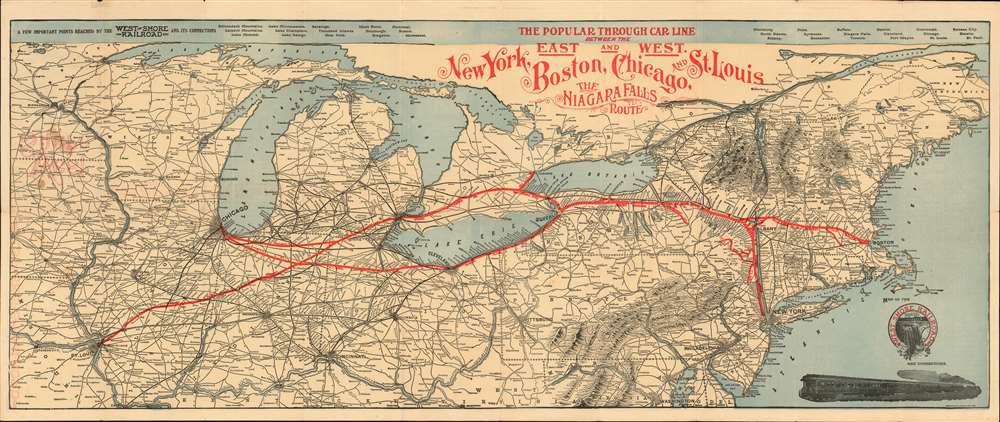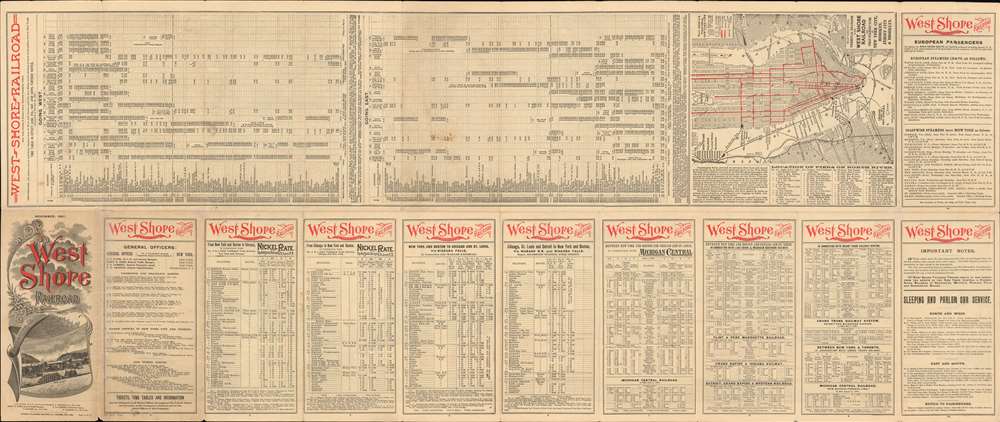1897 Wynkoop Map of West Shore Railroad: NewYork, Boston, Chicago, St. Louis
WestShoreRailroad-wynkoophallenbeck-1897
Title
1897 (dated) 16.5 x 39.5 in (41.91 x 100.33 cm) 1 : 2100000
Description
West Shore Railroad
The 'West Shore Railroad' was a 19th century New York railroad line that ran from Weehawken, New Jersey, up the Hudson Valley on the 'west shore' of the Hudson, to Albany, then west to Buffalo. The 'Hudson River West Shore Railroad' was incorporated February 16, 1867, and the 'West Shore Hudson River Railroad' was incorporated October 28, 1867, absorbing the 'Hudson River West Shore' on February 16, 1867. The 'New York Central' bought the 'New York, West Shore and Buffalo Railway' on November 24, 1885, and reorganized their new acquisition as the West Shore Railroad on December 5, leasing it for 475 years from January 1, 1886. By the end of the 19th century the West Shore had developed strategic partnerships with connecting railroads to Boston (Fitchburg Railroad), Toronto (Grand Trunk), Chicago (New York, Chicago, and St. Louis Railroad), and St. Louis (Wabash Railroad).Publication History and Census
This map was printed in 1898 by the Wynkoop Hallenbeck Crawford Co. for the West Shore Railroad. While we are not aware of any other examples, the imprint on the recto is 'Wynkoop and Hallenbeck', while the imprint on the verso is Wynkoop Hallenbeck Crawford, suggesting that an edition may have been printed before Crawford joined the firm, in 1895 or 1896. As stated, we have identified no other examples cataloged privately or in institutions.Cartographer
Wynkoop Hallenbeck Crawford Co. (fl. c. 1895 - 1925) was a large-scale printer and publisher based in New York in the late 19th and early 20th centuries. The firm originated with Matthew Bennet Wynkoop (February 15, 1830 - March 30, 1895) was born in Zanesville, Ohio and died in New York City. He mastered the printing trade in Pittsburg and moved to New York in 1850. He joined forces with John Johnson Hallenbeck (1817 - April 30, 1891) and an unknown 'Thomas' to form 'Wynkoop, Hallenbeck and Thomas'. When Thomas retired, the name was changed to 'Wynkoop and Hallenbeck', with Wynkoop being the senior partner. Wyncoop died in 1895 and shortly thereafter, Crawford joined the firm, which was consequently renamed, Wynkoop Hallenbeck Crawford. When John J. Hallenbeck died, in 1891, and his shares passed to Mr. Harry C. Hallenbeck, then a junior partner, who relocated it to Pearl street and meeting success, opened offices in Albany, New York and Lansing, Wisconsin. By 1902 they were one of the largest printing concerns in the United States. They began bidding on state contracts in 1901, acquiring contracts in Michigan. They also did extensive printing for the railroad and shipping industry. The firm seems not to have published after 1925. More by this mapmaker...




